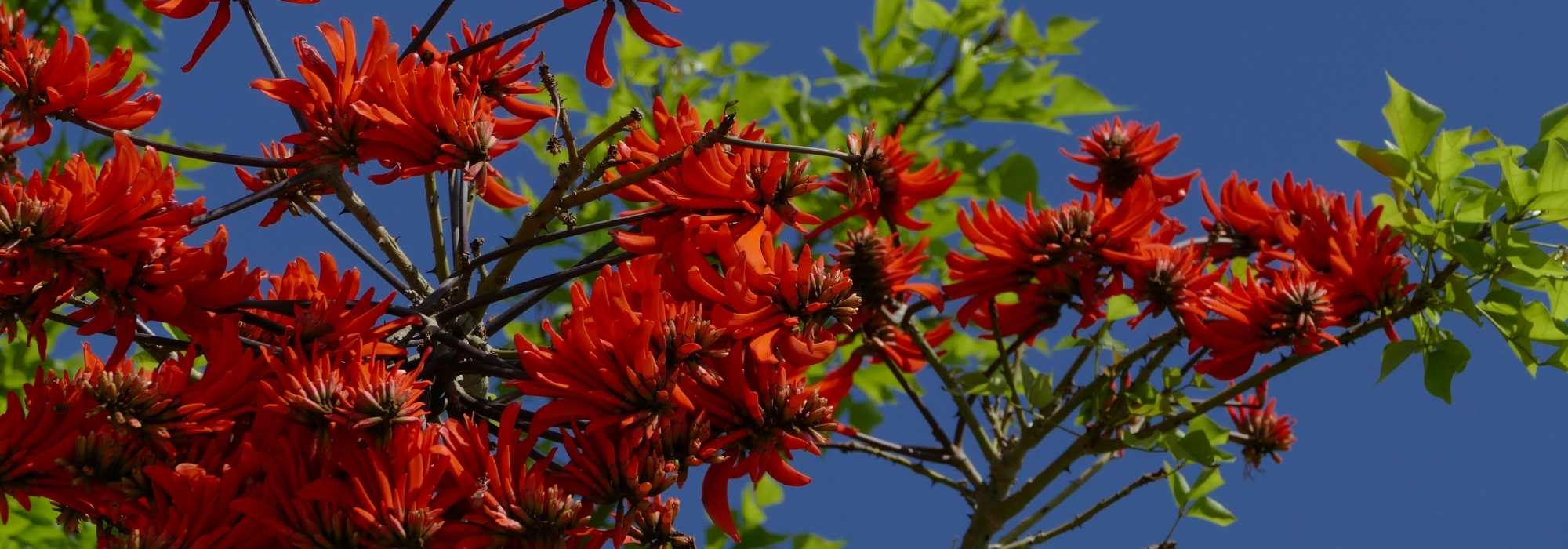
Erythrina, Coral tree: planting and care
Contents
Erythrina or coral tree in a few words
- The Erythrina, or coral bush, is a beautiful deciduous South American bush.
- It produces an original and vibrant summer flowering in the form of stunning clusters of red-orange pea-like flowers.
- Relatively frost-sensitive, it cannot be grown in open ground in our mild climate.
- In colder regions, it thrives in large pots but must be moved indoors at the first sign of frost.
- It grows in full sun in any well-drained soil.
The word from our expert
The Erythrina, also known as the Red Erythrina, Red-flowered Erythrina, or Coral Tree, is a stunning semi-hardy South American bush. In our milder regions, the Erythrina is considered a bushy plant, while in more continental climates, it is often treated as a hardy herbaceous perennial.
Its unique, somewhat gnarled silhouette and scarlet-red flowers, likened to cockscombs, make it a plant that deserves more attention in our gardens. While the most commonly cultivated variety in our latitudes is the Erythrina crista-galli, nicknamed the “Cockspur Coral Tree”, there are other equally fascinating varieties and hybrid species, such as ‘Compacta’, a highly floriferous dwarf bush, or the Erythrina x Bidwillii, which won an award at Courson in 2008.
Quite adaptable when it comes to soil and hardy enough to thrive in the ground in regions with mild winters, it is easy to grow in Mediterranean or mild oceanic climates, or in pots that can be stored frost-free, much like orangerie plants, elsewhere. It is undemanding regarding soil type, provided drainage is well-managed.
Discover our stunning varieties of the Cockspur Coral Tree and their spectacular, incandescent, and exotic flowering!
Description and Botany
Botanical data
- Latin name Erythrina
- Family Fabaceae
- Common name Coral tree, cockscomb
- Flowering June to August
- Height 1.50 to 2m
- Exposure Sun
- Soil type rich, light, well-drained
- Hardiness -10°C
The Erythrina is a small tree from the Fabaceae family, like peas, wisteria, beans, or even Albizias. It originates from South America, particularly Bolivia, Brazil, and Uruguay. It is found in tropical and subtropical regions, which explains why the Erythrina thrives in warm conditions and is only moderately hardy. It grows naturally on the edges of humid forests, along watercourses, marshes, and swamps.
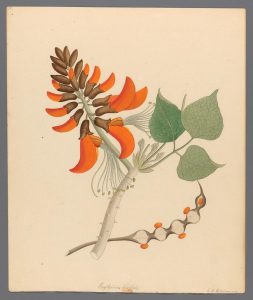
Illustration of an Erytrhina caffra
The Erythrina genus includes nearly 108 species of deciduous or semi-evergreen trees or bushes. In our gardens, the genus is mainly represented by Erythrina crista-galli, the cockspur coral tree, which is the hardiest species. It has given rise to some interesting cultivars and hybrids, such as Erythrina x Bidwillii. It is considered a bush in our warmest regions, where it forms a small tree, and as a herbaceous perennial plant not exceeding 2m in height in more continental gardens.
You can also find Erythrina lysistemon or Erythrina caffra on the French Riviera, another beautiful but less hardy species.
In its native lands, the Erythrina grows into a tree 4 to 9m tall, but in our gardens, it will reach 2 to 4m in height and 1 to 2m in spread when cultivated. The ‘Compacta’ form does not exceed 1.50m in any direction by the age of 10. The plant develops from a powerful taproot capable of fixing atmospheric nitrogen, an adaptation to poor soils. The Erythrina has a somewhat nodose habit, a slightly prehistoric appearance. It usually forms a single thick trunk with bark cracked in a crisscross pattern and sometimes adorned with a few curved black thorns.
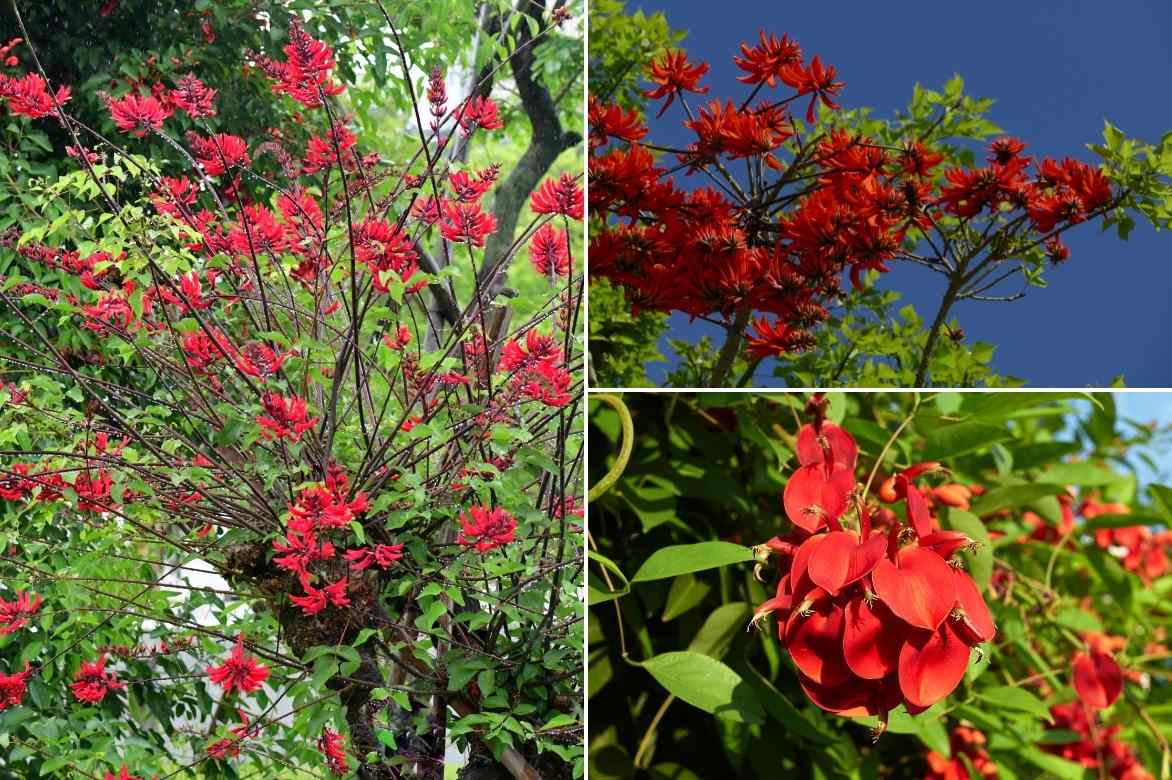
Erythrina biwilldii, Erytrhina caffra and Erythrina crista-galli
The crown is broad, spreading, slightly umbrella-shaped, and sometimes weeping. The thorny branches develop lush foliage. The Erythrina is a deciduous tree that loses its leaves during the dry season and in autumn, producing new ones in spring. The alternate leaves, 10 to 15cm long, are divided into three large heart-shaped leaflets, leathery and equipped with a thorny petiole. They are glossy blue-green to apple-green, sometimes even variegated depending on the variety.
The Erythrina is prized for its strikingly original and dazzling flowering, featuring large scarlet clusters, which has earned the bush its nicknames “Cockspur Coral Tree” or “Coral Tree”. The flowering period varies depending on the climate, starting in June in mild climates and around mid-August elsewhere. The flowers appear at the tips and along the year’s shoots, grouped in clusters often exceeding 70cm in length, sometimes reaching 1m. They are quite atypical for pea flowers. Measuring 5 to 7cm long, they consist of five unequal fused sepals, with the largest upper one forming a banner pointing downward. The other atrophied petals form a boat-like keel, from which a curved and protruding tube emerges, containing the plant’s floral organs: a cluster of stamens and the pistil. With its banners folded in half, the Erythrina x bidwillii stands out for its very elongated, almost tubular flowers. Most display a bright orange-red hue, hence its name “Cockspur Coral Tree” (Crista-galli meaning “cockscomb” in Latin).
Melliferous and nectariferous, these vermilion flowers attract numerous pollinating insects like bees and butterflies. They give way to long brownish pods resembling beans, containing black seeds.
In traditional medicine, certain Erythrina species, such as Erythrina caffra, have therapeutic properties and are used to treat arthritis, rheumatism, and toothaches.
Main species and varieties
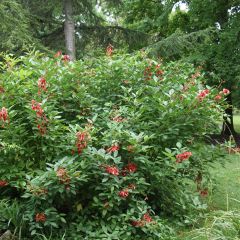
Erythrina crista-galli Compacta - Cockspur Coral Tree
- Flowering time July to September
- Height at maturity 1,50 m
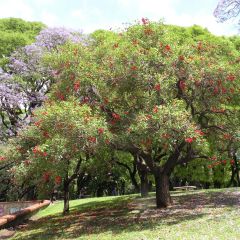
Erythrina crista-galli - Cockspur Coral Tree
- Flowering time July to September
- Height at maturity 2 m
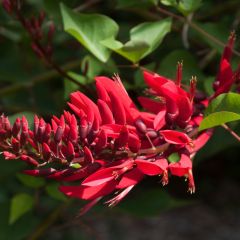
Erythrina x bidwillii - Coral Tree
- Flowering time July to October
- Height at maturity 2 m
Discover other Erythrina
View all →Available in 1 sizes
Available in 1 sizes
Available in 2 sizes
Available in 1 sizes
Available in 1 sizes
Planting the coral tree
Where to Plant It?
The Erythrina is a rather tender plant, hardy down to about -10/-15°C with protection, but its aerial parts can suffer at the slightest frost. It will thrive in gardens in the south of France. To achieve beautiful flowering, a very sunny and warm exposure is essential. In regions where frosts are brief and mild, plant it against a south-facing wall, in a spot sheltered from cold winds, and protect the stump with a thick mulch in winter. This is why this bush is best suited to open ground in regions with mild winters, such as Mediterranean or mild Atlantic climates. Gardeners in more continental areas can grow it in pots as an orangery plant, to be stored away during the cold season.
In open ground, it thrives in the sun, sheltered from prevailing winds to preserve its vibrant flowering. Native to the marshy shores of South America, while it can grow in relatively dry soil, the Erythrina prefers soils that remain moist during its flowering period. Undemanding, it tolerates poor soils and thrives in any good garden soil that is moderately fertile, very well-draining, and preferably sandy. Avoid planting it in clay soil, as it cannot tolerate waterlogging or overly compact soils, which can cause its roots to rot.
Whether in pots or open ground, this bush adds an intensely colourful and exotic touch to gardens and terraces. It can be planted at the centre or back of a flower bed, or as a standalone feature.
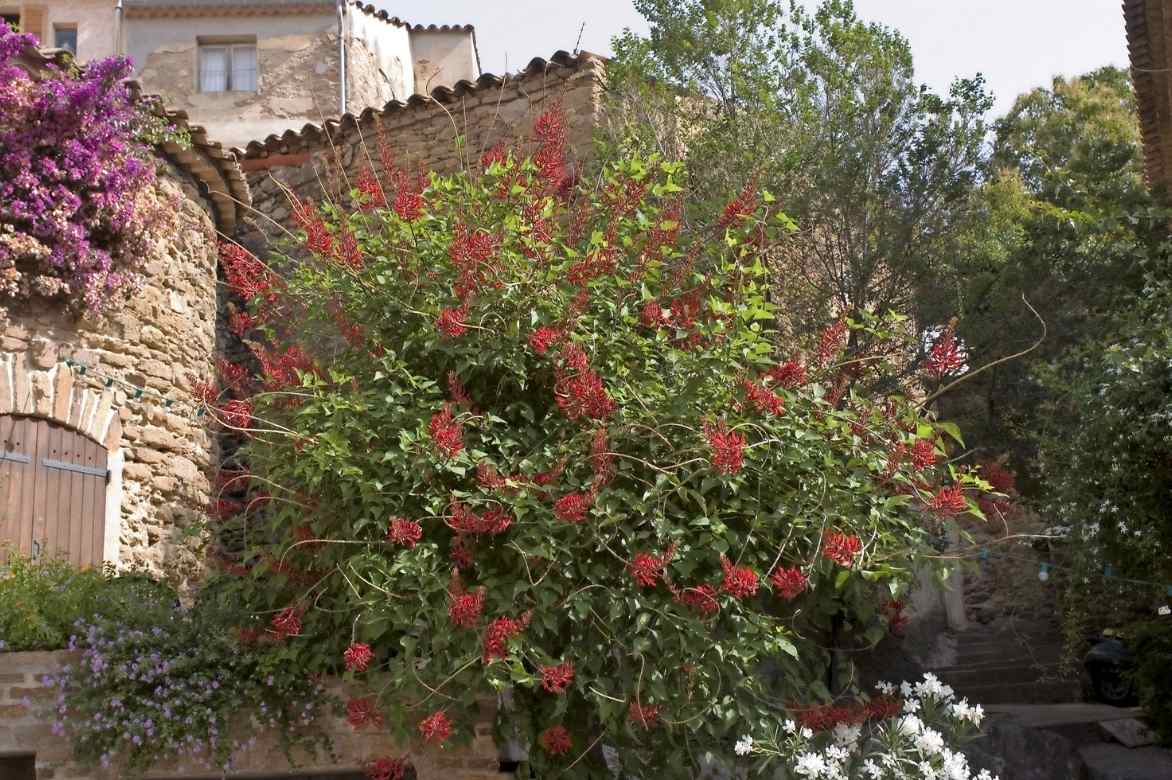
A stunning Erythrina planted in the ground in Provence
When to Plant the Erythrina?
The Erythrina is best planted in April-May, once all risk of frost has passed.
How to Plant It?
In Open Ground
Ensure your soil is lightened with draining materials during planting if it retains water.
- Dig a hole 3 to 5 times wider than the root ball (at least 60 cm in width and depth)
- Create a good drainage layer (pumice, clay pebbles, gravel) at the bottom of the hole
- Plant the bush at collar level in the centre of the hole, using a mix of 1/3 compost, 1/3 garden soil, and 1/3 coarse sand
- Firm the soil
- Mulch the base
- Water generously after planting and regularly, especially during the first summers
In Pots
Again, good drainage is essential. Choose a pot at least 50 cm in diameter.
- Spread a good layer of drainage (gravel or clay pebbles)
- Plant in a slightly sandy substrate made of 1/3 garden soil, 1/3 compost, and 1/3 sand (or simply in a mix of geranium compost + 1/3 sand).
- Bring the pot indoors at the first sign of frost in colder regions
Cultivation, pruning and care
During the first few years, it is advisable to monitor watering in summer. This bush prefers cool soil in summer. Throughout the warm season, water abundantly and regularly to keep the base cool but never waterlogged. Allow the soil to dry out between waterings.
While it enjoys having its roots cool in summer, the Erythrina appreciates a good protective layer at its base during the cold season. Mulch generously (about 30 cm) around the stump in autumn to protect it from frost, especially during the first few winters. With annual pruning and a thick layer of mulch, it will be better equipped to withstand the cold.
An application of organic fertiliser once or twice a year in spring and autumn is recommended.
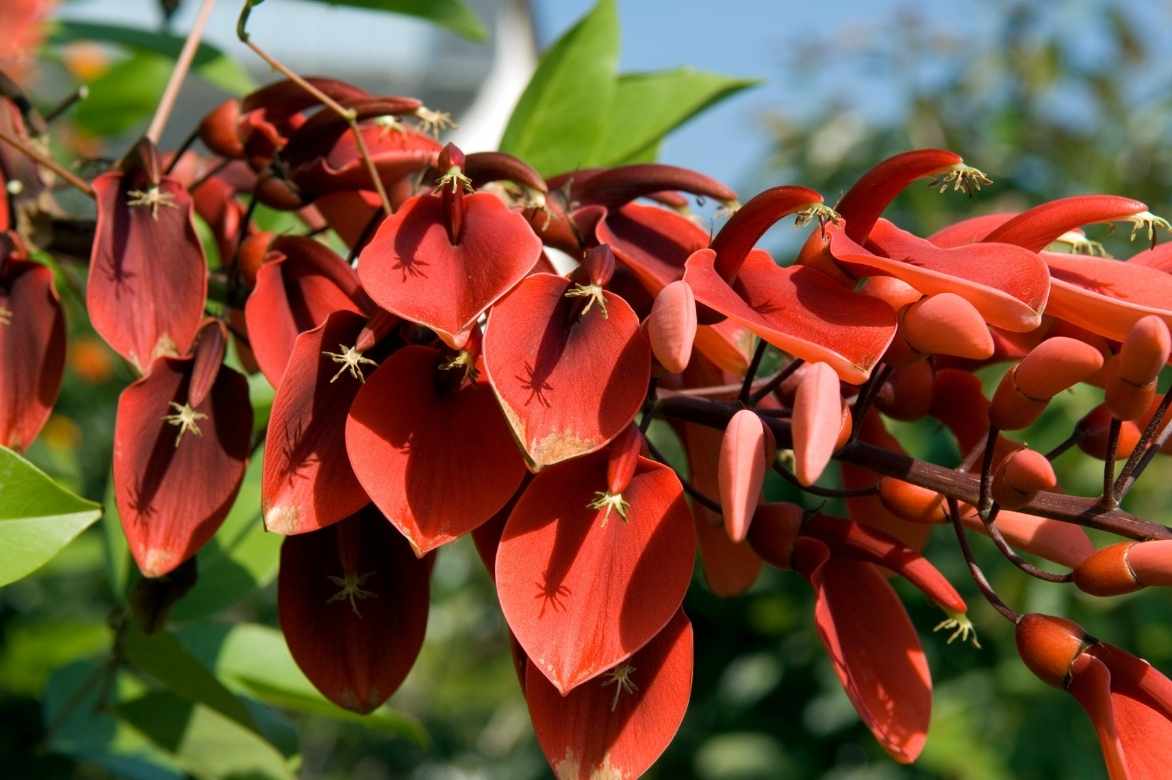
Erythrina crista-galli
In pots
Water regularly throughout the summer. During the growth period, to encourage flowering, apply a liquid fertiliser for flowering plants every two weeks. From October onwards, move the pot into a cold greenhouse or a bright, minimally heated conservatory where the temperature will not drop below 3°C. Continue to water it about once a month. Replace the substrate after 4-5 years, ideally after flowering.
How to prune it?
In our temperate climates, it is often grown more as a herbaceous plant in the ground rather than as a bushy plant because, after drastic pruning, it can regrow from the stump and quickly produce beautiful, very floriferous shoots in midsummer. Therefore, if you want to encourage its development and keep it floriferous, it will tolerate severe annual pruning.
- Cut the stems back to 10 cm from the ground, before or after frost—either in early spring or November, depending on the climate—then mulch the stump to protect it from frost and winter moisture.
- Regularly remove faded flowers to prolong the flowering period.
Multiplication
The propagation of Erythrina by sowing seeds or propagation by cuttings is possible. However, fruiting is more unpredictable and challenging in our colder regions, and you will need to be patient, as in any case, your young plants from sowing will take 3-4 years to flower. We recommend propagation by cuttings, which is easier to succeed with.
Sowing
If you already have an Erythrina in your garden, harvest the seeds from the tree, found in the pods, once they have turned brown and dry.
- Soak the seeds for 2 days
- Sow them on the surface of a good seed compost and cover them with 2 cm
- Place the sowings in a warm, humid environment at a minimum of 25°C
- Keep the substrate moist until germination
- Transplant into the garden or pots once the young plants are large enough
Cuttings
Semi-hardwood cuttings, taken at the end of summer, are simple and reliable.
- At the end of summer, take cuttings just below an eye, from shoots turning into hard wood, 4-5 cm long
- Remove the leaves from the lower third
- Plant the cuttings in a light, well-draining mix of sand and compost
- Keep the substrate moist in a humid environment until rooting, which is quick
- Transplant into individual pots
- Place them in a warm, bright spot throughout winter
- Transplant your cuttings into pots the following spring
Associate
Remarkable for its incandescent red flowering that lasts all summer, the Erythrina crista-galli (Cockscomb Coral Tree) brings a decidedly exotic touch to both the garden and a well-exposed terrace. It plays a key role in creating highly colourful and original summer scenes.
In mild climates, within a shrubby border, pair it with the Leucadendron ‘Safari Sunset’ (with its striking purple foliage), the Grevillea rosmarinifolia ‘Clearview David’ or the Lagerstroemia indica ‘Rubra’, which also boast magnificent scarlet-red flowering, or simply with Buddleias. In an exotic or Mediterranean-inspired garden, it can be combined with plants that thrive under similar growing conditions, such as the Shrubby Sage ‘Violette de Loire’, Gauras, Phormiums, or tall Sedums like the Sedum ‘Black Knight’, notable for its very dark, almost black foliage and its pink-red flowering from September to November.
It will stand out beautifully emerging from a sea of perennials. To create a striking flower colour contrast, surround its base with shrubby perennials that bloom in blue during summer, such as Salvias or the Teucrium fruticans. In autumn, it pairs wonderfully with asters, which are just as colourful.
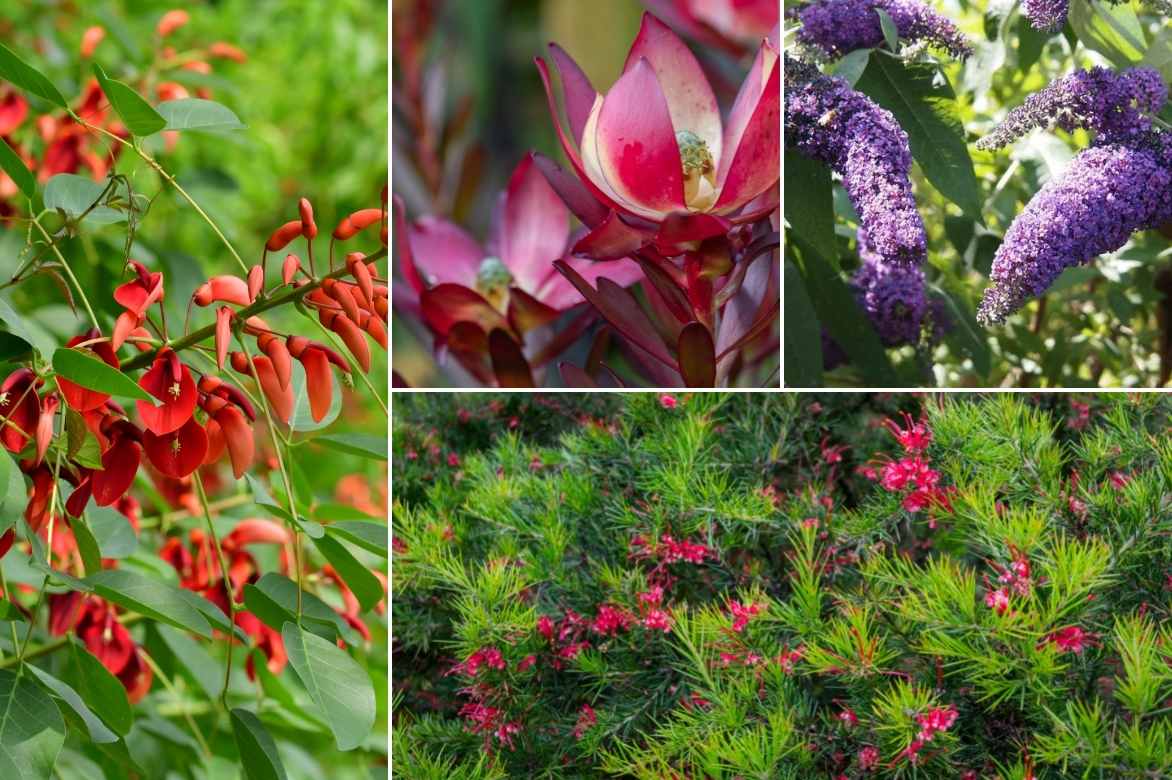
Erythrina crista-galli, Leucadendron ‘Safari Sunset’, Buddleia, and Grevillea rosmarinifolia ‘Canberra Gem’
Useful resources
- 8 landscape designer tips for creating a red garden
- Our inspirations for a red and black garden
- Our selection of red-flowering bushes
- Subscribe!
- Contents


































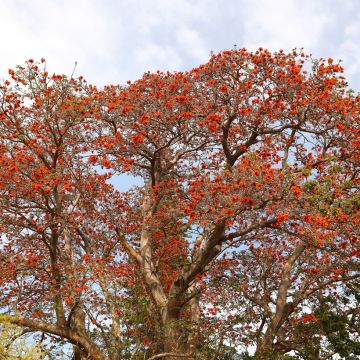
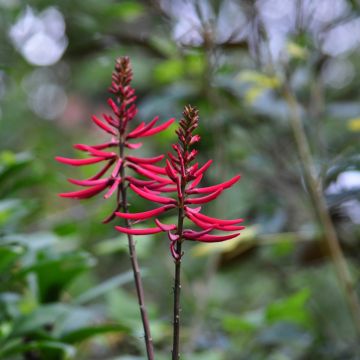
Comments